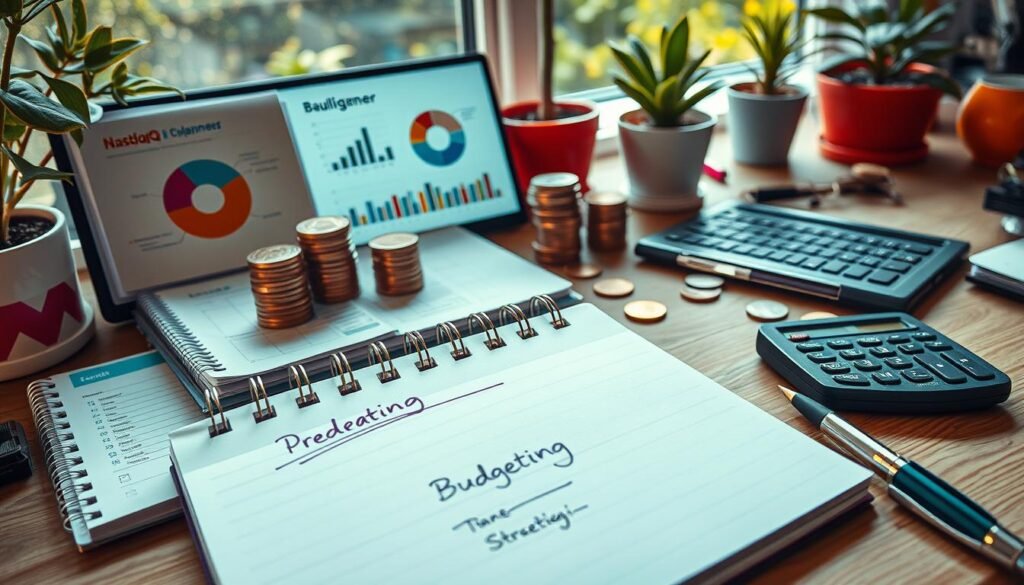Did you know nearly 60% of Americans don’t have a budget? This shows a big gap in personal finance knowledge. Learning to budget can change your financial life for the better. It’s key to good financial planning.
In this article, you’ll find useful budgeting tips. These tips will help you manage your money better. You’ll be able to reach both short-term and long-term financial goals. By learning to budget and stick to it, you can control your financial future.
Key Takeaways
- Budgeting is vital for achieving financial stability.
- Recognizing income sources and tracking expenses are crucial first steps.
- Setting short-term and long-term financial goals is essential.
- The 50/30/20 rule and zero-based budgeting are effective strategies.
- You can choose between digital budgeting tools or traditional methods.
- Regularly reviewing your budget ensures it remains relevant.
Understanding the Importance of Budgeting
Budgeting is key to your financial empowerment. It changes how you handle money. A budget helps you save and reduces financial stress.
With a budget, you can track your spending and make better choices. This leads to many budgeting benefits. You might save more and make smarter financial decisions.
Seeing budgeting as essential changes your financial life. It brings peace of mind and a secure future. Knowing your finances helps you make stable and growing choices.
| Budgeting Benefits | Impact on Financial Health |
|---|---|
| Increased Savings | Higher financial security and peace of mind |
| Reduced Financial Stress | Improved mental wellbeing and clearer focus |
| Better Spending Tracking | Enhanced control over finances and informed decisions |
| Financial Freedom | Ability to invest, travel, or pursue dreams |
What is a Budget?
A budget is a detailed plan for your money. It shows your income and expenses over time. Knowing what a budget definition is helps you manage your money better. A good budget lets you track your spending and save more.
There are many types of budgets to choose from, depending on your goals and lifestyle. Here are a few:
- Fixed Budget: Keeps expenses the same every month, making it easy to plan.
- Flexible Budget: Allows you to change costs based on what you actually spend.
- Zero-Based Budget: Uses every dollar, making sure you save as much as you can.
When making a budget, think about your income and what you spend. You can add categories that are important to you, like rent, bills, and fun money. Seeing how budgets work in real life can help you make one that fits your needs.
Creating a budget that’s just right for you is key to success. It helps you save for big things or pay off debt. A clear budget is your guide to reaching your financial goals.
Personal Finance 101: How to Create a Budget and Stick to It
Creating a budget is key to good financial planning. Start by listing your income sources. This includes your salary, side hustles, and any passive income. Knowing your total income is the first step.
Then, sort your expenses into must-haves and wants. Must-haves are things like rent, utilities, and groceries. Wants are things like dining out and hobbies. This helps you see where your money goes each month.
After listing your income and expenses, decide how much to save and spend. Setting a savings goal can improve your financial health. With clear expenses, you can stick to your budget better.
It’s also important to regularly review and adjust your budget. Life can change quickly, so being flexible is crucial. Try to check your budget every month to see how you’re doing.
Here’s a helpful table summarizing the steps for creating a budget:
| Step | Description |
|---|---|
| 1. List Income | Identify all sources of income including salaries and side jobs. |
| 2. Classify Expenses | Separate essential and discretionary expenses for better clarity. |
| 3. Allocate Funds | Decide how much to save and how much to spend in each category. |
| 4. Review Regularly | Set a monthly schedule to review and adapt your budget as needed. |
Being active with your finances helps you understand your spending. Remember, a budget is not just about cutting back. It’s about taking control of your financial future. With effort, you can stick to your budget and live a healthier financial life.
Assessing Your Current Financial Situation
To make a good budget, you must know your financial status. This means looking at both your income and spending. We’ll guide you on how to evaluate your income and track your expenses.
Evaluating Your Income Sources
First, list all your income sources. This includes your main job, side jobs, freelance work, and any other income. Knowing where your money comes from helps you budget better. Use a table to keep track of this information:
| Income Source | Monthly Amount |
|---|---|
| Salary | $3,500 |
| Freelance Work | $800 |
| Side Gigs | $400 |
| Passive Income | $200 |
| Total Income | $4,900 |
Tracking Your Expenses
Then, track your spending. Knowing where your money goes is key for budgeting. Use apps or spreadsheets to track your expenses. This helps you find ways to save money. Here are some key expense categories:
- Housing (Rent/Mortgage)
- Utilities (Electric, Water, Gas)
- Groceries
- Transportation
- Entertainment
- Dining Out
Regularly tracking your expenses helps you manage your money better. This way, you can adjust your budget to fit your needs.

Setting Financial Goals
Setting clear financial goals is key to your budgeting journey. It’s important to know the difference between short-term and long-term goals. This helps you plan your spending and saving better.
Having clear goals makes your financial decisions better. It ensures you’re working towards your big financial dreams.
Short-term vs Long-term Goals
Short-term goals are for things you want in less than a year. This could be saving for a trip, paying off small debts, or building an emergency fund. On the other hand, long-term goals are for bigger things like buying a home or saving for retirement.
Knowing the difference helps you budget better. It lets you reach both quick wins and big goals.
SMART Goals for Financial Success
Using SMART criteria makes setting goals better. SMART stands for Specific, Measurable, Achievable, Relevant, and Time-bound. It helps you set goals that are clear, trackable, and reachable.
SMART goals help you reach both short-term and long-term goals. This leads to a more secure financial future.
| Goal Type | Examples | Timeline |
|---|---|---|
| Short-term Goals | Vacation savings, emergency fund, paying off credit card debt | Less than 1 year |
| Long-term Goals | Buying a home, retirement savings, children’s education | More than 1 year |
Budgeting Strategies That Work
Choosing the right budgeting strategies is key to managing your money. Two effective methods are the 50/30/20 rule and zero-based budgeting. Each has its own benefits, fitting different spending habits and financial goals.
The 50/30/20 Rule
The 50/30/20 rule makes budgeting easy by dividing your income into three parts. Fifty percent goes to needs like rent and bills. Thirty percent is for wants, like fun and dining out. And twenty percent is for savings or paying off debt.
This rule helps you plan clearly and reduces financial stress. It makes budgeting straightforward.
Zero-Based Budgeting
Zero-based budgeting assigns every dollar of your income to a specific use. This leaves you with a balanced budget of zero. It means you track and use your money wisely, for expenses, savings, or debt.
This method is great for those who like to check every expense. It helps you use your money efficiently and stay in control of your spending.

Choosing a Budgeting Method
Choosing the right budgeting method is key to managing your money well. You can use a digital budget tracker or stick with old-school methods like paper and pencil. Each has its own benefits, and picking the right one depends on what you like and how you live.
Digital Budget Trackers and Apps
Digital tools like Mint and YNAB make tracking money easy. They sync with your bank and offer a simple interface. Here’s why they’re great:
- Real-time tracking: See your money as it changes.
- Automated categorization: Your spending is sorted for you.
- Accessibility: Check your budget anywhere, anytime.
But, some might feel too tied to tech. It can make them less connected to their money.
Pencil and Paper Methods
DIY budgeting with paper and pencil is a hands-on way to manage money. It might include spreadsheets or notebooks. Here’s why it’s good:
- Greater awareness: Writing it down makes it stick in your mind.
- Customized layout: Make your budget fit your needs.
- No technology required: Perfect for those who don’t like apps.
Deciding between digital and paper budgeting depends on what you prefer. Both can help you stay on top of your finances.
Implementing Your Budget
Getting your budget right is key to your financial well-being. After you’ve made your budget, it’s time to live by it. This means changing how you spend money to match your budget.
Staying disciplined with your finances is crucial. You must stick to your budget and avoid spending too much. To stay on track, set reminders or join groups that help you make smart money choices.
Remember, changing your spending habits takes time. It’s okay to face challenges along the way. The goal is to keep up with your budget and build good money habits for the long run.

Common Budgeting Mistakes to Avoid
Creating a budget is a key step toward achieving your financial goals, yet many people fall into common budgeting mistakes. Recognizing these pitfalls in budgeting can help you improve your financial planning significantly. Here are some prevalent errors to watch for:
- Underestimating Expenses: Failing to account for all monthly costs, such as utilities, groceries, and miscellaneous spending, can lead to serious financial errors.
- Setting Unrealistic Goals: Crafting financial objectives that are too ambitious often results in disappointment and discouragement.
- Neglecting to Track Spending: Without accurate tracking, overspending becomes a frequent issue, leading to financial errors that can ruin your overall budget.
- Ignoring Irregular Expenses: Annual fees or irregular costs can catch you off guard if not included in your budget.
- Failing to Adjust: Life changes often necessitate updates to your budget. Rigid adherence to an outdated plan can be detrimental.
By being aware of these typical budgeting mistakes, you can better navigate your financial journey. Each of these pitfalls in budgeting is a chance to learn and improve, ultimately leading to a more secure financial future.
| Budgeting Mistake | Potential Consequences | Best Practices |
|---|---|---|
| Underestimating Expenses | Overspending and debt accumulation | Track all monthly expenses accurately |
| Setting Unrealistic Goals | Frustration and giving up on budgeting | Set achievable and incremental goals |
| Neglecting to Track Spending | Uncontrolled spending habits | Regularly monitor expenditures |
| Ignoring Irregular Expenses | Surprise costs that disrupt cash flow | Include all atypical expenses in your budget |
| Failing to Adjust | Stagnation in financial growth | Review and update your budget periodically |
How to Stick to Your Budget
Keeping to a budget can be tough, but with the right steps, you can reach your money goals. Being accountable in your budget helps a lot. Also, checking your budget often keeps you focused on saving money.
Tips for Staying Accountable
To stay on track with your budget, try these helpful tips:
- Have weekly or monthly meetings with yourself or a budget buddy.
- Use budget apps to see how you’re doing right away.
- Set reminders for when bills are due and other money matters.
- Join a budget group or online community for help and encouragement.
Adjusting Your Budget When Needed
Being flexible with your budget is important. Unexpected costs or income changes can happen. Here’s how to handle them:
- Check your budget every month to see if you need to make changes.
- Understand that money can change due to holidays or health issues.
- Focus on must-haves and cut back on wants if you need to.
- Have an emergency fund to protect against sudden expenses.
| Action | Benefits |
|---|---|
| Weekly Check-ins | Encourages consistent monitoring of expenses. |
| Budgeting Apps | Provides instant feedback and tracking. |
| Adjusting Plans | Helps manage unforeseen financial changes effectively. |
| Emergency Fund | Offers security and reduces stress during tough times. |
By using these strategies and being prepared for budget changes, you can do better with your budget. Saving money is a journey. Every step you take brings you closer to your goals.
Reviewing Your Budget Regularly
Keeping a close eye on your budget is key to staying financially healthy. It helps you see if your spending matches your goals. By regularly checking your budget, you can quickly handle any surprises.
Decide how often you want to review your budget. Some people like to do it monthly, while others prefer every two weeks. The important thing is to find a schedule that works for you and gives you the financial insight you need.
When you review your budget, look out for these signs:
- Income fluctuations – Check if your earnings have changed a lot and need adjusting.
- Expense patterns – See if your spending has gone up or down in any big ways.
- Goal alignment – Make sure your spending fits with your financial plans.
- Unforeseen expenses – Note any unexpected costs that might affect your budget.
- Keep a record of all your spending to track your habits.
- Update your budget for seasonal changes in costs.
- Get a partner or family member to help you stay on track.
By regularly reviewing and adjusting your budget, you gain better control over your money. This helps you stay financially healthy and ready for any future challenges.
Conclusion
We’ve looked at the key steps to a stable financial future. You now know what a budget is and how to assess your finances. Setting goals and choosing a budget method that suits you is crucial.
A good budget helps you control spending and save. It shows that planning and commitment are vital. This way, you can manage your money better.
Don’t let your financial future seem too big. Start using the budgeting tips we’ve shared. Remember, adjusting your budget as your needs change is okay and sometimes necessary.
Small changes can lead to big wins over time. Keep working on your budgeting skills. This will help you achieve your financial goals.
Think about learning more about personal finance. Books, podcasts, and workshops can help. More knowledge means you can handle your finances with confidence and purpose.
FAQ
What are the basic steps to create a budget?
To start a budget, first, list all your income sources. Then, categorize your expenses into fixed and variable costs. Don’t forget to save a portion of your income. Regularly review and adjust your budget to meet your financial goals.
How can I stick to my budget effectively?
Staying on budget needs discipline and accountability. Use apps to track your spending. Set regular check-ins to review your goals. Adjust as needed to stay on track without feeling trapped.
What budgeting methods are the most popular?
Popular methods include the 50/30/20 Rule and zero-based budgeting. The 50/30/20 Rule divides income into needs, wants, and savings. Zero-based budgeting allocates every dollar to a purpose. Try digital tools like Mint or YNAB for ease.
What common budgeting mistakes should I avoid?
Avoid underestimating expenses and not reviewing your budget often. Also, don’t set unrealistic goals. Understand your spending habits well and adjust your budget accordingly.
How often should I review my budget?
Review your budget monthly. Regular checks help you stay on track financially. Track your progress quarterly to meet savings and spending goals.
Can budgeting help alleviate financial stress?
Yes, budgeting clarifies your finances. It helps control spending and prioritize savings. This clarity reduces money anxiety and empowers smart financial decisions.
What tools can I use to track my budget?
Many tools help track your budget. Digital apps like Mint, YNAB, and EveryDollar are great. For a traditional approach, use Excel or pen and paper.
How do I set effective financial goals?
Set goals using the SMART criteria: Specific, Measurable, Achievable, Relevant, and Time-bound. This method clarifies your goals and creates a roadmap for success, whether short-term or long-term.



